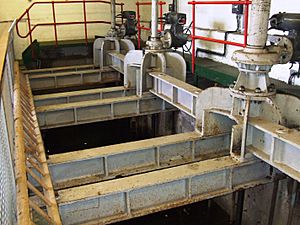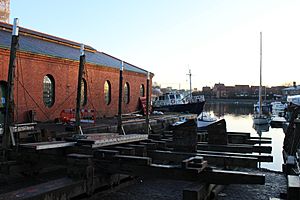Underfall Yard facts for kids
The Underfall Yard is a special historic boatyard located on Spike Island in Bristol Harbour, England. It's a place where ships and boats have been repaired and maintained for a very long time.
People sometimes called it "The Underfalls." Its name comes from the "underfall sluices" – these are like special gates that control water. The yard was first built in 1809 by William Jessop. Later, in the 1830s, a famous engineer named Isambard Kingdom Brunel made big improvements to it.
In the 1990s, the Underfall Yard was restored. Many of its buildings are now protected as Grade II Listed Buildings, meaning they are important historical structures. The harbour and its equipment are still looked after today. Many companies that work with boats and the sea are based there.
Contents
History of the Yard
In the early 1800s, Bristol's harbour had a big problem: ships would get stuck in the mud when the tide went out. To fix this, an engineer named William Jessop designed a "Floating Harbour" in 1809. He built a lock to keep the water level high, so ships could always float.
As part of this project, Jessop also built a dam at the Underfall Yard. This dam had a weir (a small dam) called the Overfall. It let extra river water flow into a new channel called the New Cut, which bypassed the main harbour.
The Underfall Yard became the main place for maintaining the docks. But by the 1830s, the Floating Harbour was getting very muddy. Isambard Kingdom Brunel came up with a clever solution: the "underfall sluices." These were based on Jessop's original ideas. Brunel also suggested using dredgers, which are machines that scoop up mud from the bottom of the harbour.
The company that ran the docks wasn't very successful, so Bristol City Council took over in 1848. In 1880, the Council bought the Slipway and the rest of the yard to make the maintenance facilities even bigger.
The "Underfall" system was rebuilt in the 1880s with longer sluices. Brunel's method of removing mud is still used today! The mud is carried away in special barges or pumped through pipes to the sluices by modern dredgers.
During the 1900s, parts of the yard were used by a company called P & A Campbell Ltd. They maintained their paddle steamers there. The yard hasn't changed much recently, except for one building that was rebuilt after being damaged in World War II.
The Underfall Yard has been carefully restored by the Underfall Yard Trust. Today, it's home to maritime schools, a scout sailing group, a blacksmith, and several boat-building businesses.
In 2015, a big restoration project began. This included building a cafe and a visitor centre. They also started collecting stories from people who worked there and created educational programs for schools.
Sadly, in May 2023, a fire caused damage to several boats and a maintenance shed at the yard.
How the Underfall Sluices Work
When Jessop first designed the harbour, he included a dam with an "overfall." This meant the water level was set by the height of the dam. But mud and silt kept building up, making it hard for ships to move.
In 1832, Brunel was asked to solve this problem. He designed the sluice system that is still used today to clear out the mud. Instead of the Overfall, he built three shallow sluices and one deep "scouring" sluice. These sluices connect the harbour to the New Cut. He also designed a special boat called a "drag boat" to scrape mud from the quay walls.
Sluices 1, 2, and 4 (the shallow ones) help control the water level. Sluice 3 (the deep one) is for removing silt. When the deep sluice is opened at low tide, it creates a powerful "undertow." This strong current sucks the mud out of the harbour and into the river.
The sluices have been changed and updated over the years. The current system was put in place in the 1880s. In March 1988, the sluice controls became computerised and automated, making them easier to operate.
Important Buildings at the Yard
Most of the buildings and machinery at Underfall Yard were built between 1880 and 1890 by John Ward Girdlestone. Many of them are now protected as listed buildings because of their historical importance.
The Engine House and Chimney
The tall, eight-sided brick and terracotta chimney of the engine house was built in 1888. It's a very important historical building. The hydraulic engine house itself is also protected. It replaced an older pumping house, which is now the visitor centre.
The engine house is made of red brick with a slate roof. It originally had two steam-powered pumps. These were replaced in 1907 by electric machines. These machines powered the docks' hydraulic system, which operated cranes, bridges, and locks.

The tower next to the engine house holds a large weight called a Hydraulic accumulator. This accumulator stores hydraulic energy. It helps keep the water pressure smooth and steady, so the pumps don't have to run all the time. An external accumulator was added in 1954. Water is pumped from the harbour into a tank, then flows by gravity to the pumps. The working pressure is very high, about 750 pounds per square inch.
Dock Maintenance Workshops
The dock maintenance workshops are from the 1880s, but they were made bigger in the early 1900s. This brick building has a tiled roof and sliding doors. Inside, you can find the boiler and engine houses, a blacksmith's shop, and engineer's shops.
Many of the original machines are still there! These include steam-powered tools from the 1880s, like a planing machine, a slotting machine, and a steam hammer. There's also old line-shafting (a system of belts and pulleys to power machines) and a horizontal engine with a Cornish boiler.
Pattern Maker's Shop
The old pattern-maker's shop and storage areas are also historically protected. A pattern maker creates wooden models (patterns) that are used to make molds for metal casting.
Many of the original wooden patterns still exist. Some are used for teaching, some are on display, and others are still used for work. Today, a business called RB Boatbuilding Ltd uses this shop. They build classic wooden boats, like the Bristol Channel Pilot Cutter. The Slipway Co-operative Ltd also manages the slipping of boats here. They build, repair, and restore wooden boats, including the 14-foot Bristol Jolly Boat.
The Slipway
The original slipway was built in 1890 by John Ward Girdlestone. It replaced an earlier one from the 1850s. A slipway is a ramp where ships can be pulled out of the water for maintenance. A ship floats onto a special cradle, which is then pulled out of the water by a steam-driven winch. This was a cheaper way to repair boats than using dry docks. This type of slipway was called a Patent slipway or "Heave-up Slip."
The 1890 slipway was first powered by the dock's hydraulic system. In 1924, an electric motor was installed, which still works today. The Bristol slipway is quite small, with a cradle about 100 feet long. It can lift vessels up to 250 tons.
The slipway stopped being used by 1974. But in the 1990s, members of the Slipway Co-operative and Underfall Trust rebuilt it. They had to replace the underwater part with steel supports. The track above water was relaid, reusing the original cast iron rails. The cradle was completely rebuilt to look like the original. Getting the slipway working again was very important for keeping the Underfall Yard alive, as it helped fund the maintenance of the yard and provided work for the businesses there.
The Pump Room
The power house at Underfall Yard was built in 1887. Its job was to provide hydraulic power to all the cranes, bridges, and locks around the floating harbour. It was first powered by steam, which is why the large chimney is still there.
The room that is now the visitor centre used to hold three boilers that powered steam hydraulic pumps. In the room next to the visitor centre, there are three electric pumps. These pumps were installed in 1907, replacing the original ones. They are often run to show visitors how they worked.
The Big Shed
The Big Shed was originally used to build very large items, like lock gates. Today, maritime businesses use it, but it's not open to the public.
See also
- The Underfall Yard - an album by a British progressive rock band, inspired by the Underfall Yard and other projects by Victorian engineers.
Bristol Harbour Map
- Prince's Wharf, including M Shed, Pyronaut and Mayflower adjoining Prince Street Bridge
- Dry docks: SS Great Britain, the Matthew
- St Augustine's Reach, Pero's Bridge
- Bathurst Basin
- Queen Square
- Bristol Temple Meads railway station
- Castle Park
- Redcliffe Quay and Redcliffe Caves
- Baltic Wharf marina
- Cumberland Basin & Brunel Locks
- The New Cut
- Netham Lock, entrance to the Feeder Canal
- Totterdown Basin
- Temple Quay
- The Centre
- Canons Marsh, including Millennium Square and At-Bristol
- Underfall Yard
- Bristol Bridge





